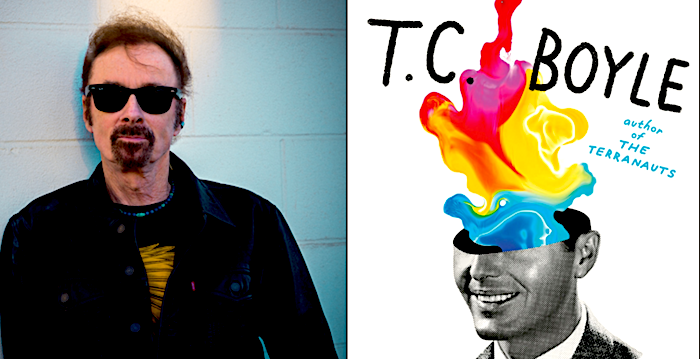Outside Looking In
by T.C. Boyle
Harper Collins 2019
$27.99
Reviewed by Vincent Zangrillo
TC Boyle’s new novel, Outside Looking In, explores the luminous world of Dr. Timothy Leary’s early years, while LSD was still legal. The foreword to the novel tells the events surrounding Bicycle Day, April 19th, 1943 when Albert Hoffman first intentionally ingested his 25th iteration of lysergic acid diethylamide and like Dr. Jekyll or Dr. Jack Griffin in The Invisible Man goes back for more, becoming the subject of his own experiment.

The novel then flash-forwards to Cambridge in 1962, where Leary and Richard Albert (later known as Ram Dass) conduct experiments with the newly available LSD-25. Their previous tests with psilocybin didn’t take them as far out in the cosmos and as far deep into their consciousness as the ramped up LSD -25 was able to. Among the graduate and then undergraduate participants (which resulted in his and Albert’s firing) are the main characters of this novel, Fitz and Joanie Corley, who have a thirteen-year-old son, Corey. Fitz, a grad student struggling to finish his PhD, and his librarian-assistant wife Joanie, become part of the inner circle. In for a dime in for a dollar, they accompany Dr. Leary and entourage to Zihuatanejo, Mexico, and later—through the largesse of Billy and Peggy Hitchcock–to the Hitchcock Estate in Millbrook, New York, a staid country village about two hours north of New York City.
Throughout the novel, Boyle sticks to a close third-person point of view where narration and character blend, a technique favored by novelists in in modern American literature, switching back and forth between Fitz and Joanie’s perspective. He also provides plenty of exposition, in case someone picks up the novel who has not Tuned In and Turned On. Interestingly, this work does not explore Leary directly but rather the effect he has on the young couple and others in his orbit. It’s as if Leary is the Sun, one can’t look at it directly, but rather must view it through a pinhole projector.
Boyle declines to flesh out the other countercultural figures who come by Millbrook to find God, or party, or both, as the case might be. These include Allen Ginsberg, who pops up only as a case of mistaken identity, and the fleeting presence of the Merry Pranksters, who show up after the bus, Further, had taken its legendary cross country trip (told in depth in Tom Wolfe’s The Electric Kool Aid Acid Test.) Only Kesey and Ken Babbs are mentioned by name, and there is scant description of the novelist, Robert Stone, or the DRIVER, the fabled Neal Cassady. But Boyle sticks to his main character’s perspective, relating the Prankster visit as just an annoyance to Fitz, who day by day is becoming less and less of a purist.
T.C. Boyle is a prolific novelist and short story writer, slightly off the public radar and in full command of his writing chops. He is an expert at ratcheting up tension. He does this to great effect in Outside Looking In. There are two deaths in the book. The first is an annoying zonked-out pet monkey who has never been potty-trained or learned to swim, who drowns in the pond on the Millbrook Estate. The second death is the marriage of Fitz and Joanie, which drowns in a sea of drugs and sexual experimentation, a sort of psychedelic swinger’s scene, touted by Leary as another tool to dissolve ego identity and attachment.
This is not a novel that stands as some sort of advertisement or nostalgic view of LSD before Haight Ashbury and Woodstock. Rather one takes from it a very simple lesson: Drugs, alcohol and infidelity are not good for a relationship.
Boyle has a history of exploring the lives of figures like Leary in 20th-century America, including novels about Alfred Kinsey and John Harvey Kellogg, who also created a society within a society and formed cults of personality. Boyle has said that he is distrustful of gurus and the effect of giving yourself up. He explores the underside of these icons, classic American narcissists and snake-oil salesman, who, were part of the American cultural landscape from the beginning of our nation. And that brings us to the next lesson: Beware of charismatic men bearing gifts. The influence of such “leaders,” from P.T. Barnum to Billy Sunday to Hugh Hefner to Leary, on not just the current cultural climate but our cultural DNA, cannot be underestimated. Witness today’s popularity of “I believe-ism,” everything from homeopathic medicine to microdosing to Evangelical Christianity and late-stage capitalism.
The Cambridge/ Zihuatanejo / Millbrook years were relatively (with a heavy stress on the word relatively) tranquil years for Tim. Once LSD became illegal, things got a lot heavier for Dr. Leary. One can only hope that T.C. Boyle decides to write a sequel. Until then, tune into Outside Looking In. It’s a rush.
–Vincent Zangrillo
.
Reviews
Incisive, eloquently written review…
I’ll now go out and read this seemingly fascinating book!
Sohbet Ve Chat Uygulaması.https://sohbetbe.blogspot.com/
Üyeliksiz Sohbet Ve Üyeliksiz Chat Uygulaması.https://livechattt.blogspot.com/
Cinsel Sohbet Ve Cinsel Chat Uygulaması.https://askyeriniz.blogspot.com/